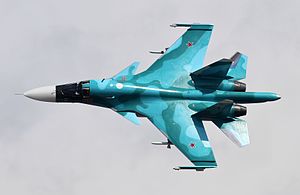Su-34
| Su-32/34 | |
|---|---|
 |
|
| Russian Air Force Su-34 | |
| Role | Fighter-bomber,strike fighter |
| Manufacturer | Sukhoi |
| First flight | April 13, 1990 |
| Introduction | March 20, 2014 |
| Status | In service |
| Primary user | Russian Air Force |
| Produced | 2006–present |
| Number built | 107 as of December 2016 |
| Unit cost |
US$36 million
|
| Developed from | Sukhoi Su-27 |
The Sukhoi Su-34 (Russian: Сухой Су-34) (NATO reporting name: Fullback) is a Russian twin-engine, twin-seat strike fighter. It is intended to replace the Sukhoi Su-24.
Based on the Sukhoi Su-27 'Flanker', the two-seat Su-34 is designed primarily for tactical deployment against ground and naval targets (tactical bombing/attack/interdiction roles, including against small and mobile targets) on solo and group missions in daytime and at night, under favourable and adverse weather conditions and in a hostile environment with counter-fire and EW counter-measures deployed, as well as for aerial reconnaissance.
The Su-34 had a muddied and protracted beginning. In the mid-1980s, Sukhoi began developing a new tactical multirole combat aircraft to replace the swing-wing Su-24, which would incorporate a host of conflicting requirements. The bureau thus selected the Su-27, which excelled in maneuverability and range, and could carry a large payload, as the basis for the new fighter-bomber. More specifically, the aircraft was developed from T10KM-2, the naval trainer derivative of the Sukhoi Su-27K. The development, known internally as T-10V, was shelved at the end of the 1980s sharing the fate of Soviet aircraft carrier Ulyanovsk; this was the result of the political upheaval in the Soviet Union and its subsequent disintegration.
In August 1990, a photograph taken by a TASS officer showed an aircraft making a dummy approach towards the aircraft carrier Tbilisi. The aircraft, subsequently and erroneously labelled Su-27KU by Western intelligence, made its maiden flight on 13 April 1990 with Anatoliy Ivanov at the controls. Converted from an Su-27UB with the new distinctive nose, while retaining the main undercarriage of previous Su-27s, it was a prototype for the Su-27IB (Istrebitel Bombardirovshchik, or "fighter bomber"). It was developed in parallel with the two-seat naval trainer, the Su-27KUB. However, contrary to earlier reports, the two aircraft are not directly related. Flight tests continued throughout 1990 and into 1991.
...
Wikipedia
